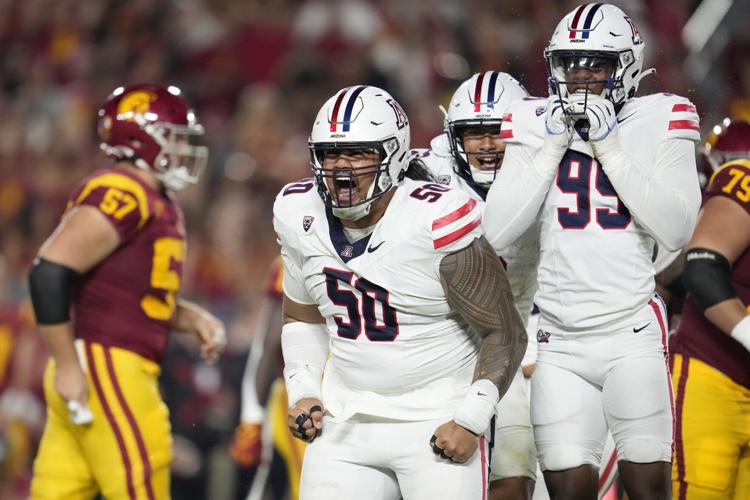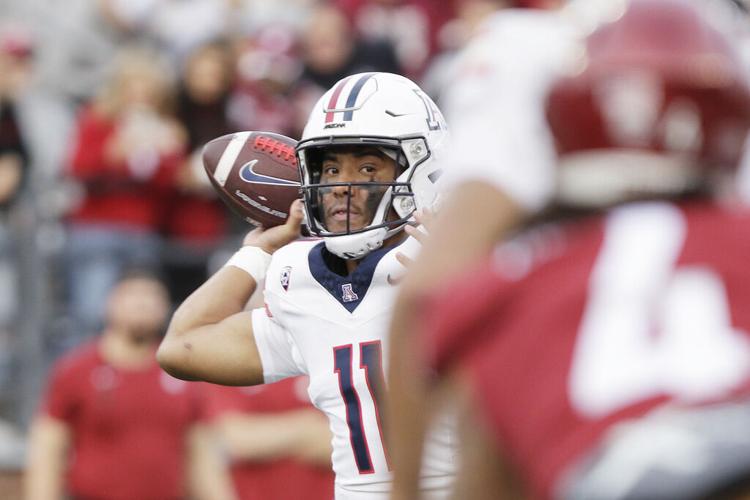We know all about the big stuff by now.
The Arizona Wildcats are vastly improved at stopping the run. They’re allowing significantly fewer points per game. Those are the main reasons they’re 4-3 and on track to make a bowl game for the first time since 2017.
But we always dig deeper here at “Cats Stats.” What follows are seven sets of statistics that further illustrate Arizona’s improvement through seven games.
Next week — when the Wildcats return from their bye and prep for a visit from No. 12 Oregon State, the first of five games to conclude the regular season — we’ll examine five areas where they still have room for growth.

YARDS PER PLAY
We’ll start with something fairly basic but too often overlooked: What happens, on average, every time Arizona and its opponents run a play from scrimmage?
The Wildcats are averaging 6.55 yards per play, which ranks 27th nationally and is actually down slightly from last year’s 6.84 (11th). But the picture changes when you look at the difference between what Arizona is gaining and what it’s allowing.
The Wildcats are surrendering 5.39 yards per play, which ranks 58th nationally and is significantly better than last year’s 6.59 (126th).
The net difference between offense and defense on a per-play basis this year: plus-1.16 yards. The year before, it was plus-.25. In 2021, it was minus-.97.
If that trend doesn’t represent program progress, what does?
FIRST DOWNS
This is another essential element of football that we probably don’t talk about enough.
Arizona is averaging about the same number of first downs per game as last season — 24.7 vs. 24.2. But again, the difference between offense and defense is where the real change can be found.
The Wildcats are allowing 18 first downs per game, which is tied for 33rd nationally, down from 25.6 last season (128th). On a per-game basis, they’re gaining 6.7 more first downs than their opponents. That figure was minus-1.4 in 2022.
Correspondingly, Arizona is above water in time of possession. The Wildcats are possessing the ball for 31 minutes and 33 seconds per game — up from 28:03 last season.
Some will tell you that time of possession is irrelevant and that total plays matter more. But it sure is nice when your offense can keep the opposing defense on the field — and your defense can rest on the sideline.
FOURTH DOWNS
We talk so much about third down, which, irrefutably, is the money down in American football. But what about its underrated cousin, fourth down?
Teams are going for it on fourth down more than ever these days, and those decisions generate unrelenting criticism when they don’t work. Just ask Dan Lanning.
Jedd Fisch has been aggressive on fourth down since his first game as UA coach. He has gone for it on fourth-and-short from Arizona’s side of the field countless times, and he typically eschews long field goal attempts if he thinks the Wildcats can convert.
This year, they’ve converted fourth downs at a higher rate while limiting opponents to a lower percentage.
Arizona is 9 of 14 on fourth down, a conversion rate of 64.3% that ranks 32nd nationally. The Wildcats are 9 of 12 (75%) since the opener vs. NAU.
Last year, Arizona converted just 10 of 23 fourth-down attempts for a success rate of 43.9% (tied for 101st nationally).
Meanwhile, on defense, Arizona has allowed just 3 of 10 fourth-down conversions. The Wildcats’ opponent success rate of 30% ranks first in the Pac-12 and 12th nationally. Last year, that figure was 57.1%, eighth in the Pac-12 and tied for 86th nationally.
Fourth-down plays can be game-changers. Against Mississippi State, Jayden de Laura got stopped inches short on a fourth-and-10 scramble in overtime. Had he converted, Arizona would have had a chance to tie the score or win the game.
Against Washington, Arizona converted three fourth-and-1 plays from inside its 35 — one by Jonah Coleman, two by DJ Williams — that enabled the Wildcats to hang with the Huskies.
And last week, the UA stymied Washington State on all three of its fourth-down tries — including a fourth-and-1 stop by defensive tackle Jacob Kongaika that shifted momentum in the first quarter.

Arizona defensive lineman Sio Nofoagatoto’a (50) celebrates after a sack by teammate Russell Davis II (99) on USC quarterback Caleb Williams, college football’s reigning Heisman Trophy winner, during the first half of the Wildcats’ near-upset in double overtime against the Trojans on Oct. 7.
DEFENSIVE DEPTH
This isn’t a stat in the traditional sense, but there is a way to quantify Arizona’s enhanced defensive depth — especially up front.
So far this season, only one UA defensive lineman, Taylor Upshaw, is averaging more than 40 snaps per game (41.1). In each of the previous two seasons, three UA defensive linemen averaged at least 44.6 snaps — and two averaged 53 or more.
Meanwhile, nine UA defensive linemen have played at least 25% of the snaps — up from seven last year and six the year before. So more D-linemen are getting in the mix, but none are being overworked.
Overall, 21 UA defenders have played at least 25% of the snaps — up from 17 last season and 16 in 2021.
Related: Arizona has outscored the opposition by a wide margin in the second (62-34), third (65-28) and fourth (56-23) quarters.
SACK DIFFERENTIAL
This is one of our longtime favorites because it’s a driver of “hidden yardage.”
In Fisch’s first two seasons, Arizona allowed more sacks than it recorded. In 2021, the differential was minus-13; last year it was minus-7.
It’s even more stark when you look at yards lost. The Wildcats lost 251 yards on sacks in ’21, while their own sacks produced 139 yards in losses — a difference of 112 yards. Last year that figure was 130.
This year? A whole different ballgame.
Arizona has recorded 19 sacks while allowing 12 for a net of plus-7. The Wildcats are plus-55 in sack yardage lost.
Also notable: The Wildcats already have three more sacks than they had all of last season. Their 16 sacks in 2022 tied for the fourth fewest in the country.
RED ZONE
This was a major talking point each of the past two seasons. It hasn’t been discussed as much, if at all, this year because Arizona has gotten much better inside the 20-yard line — on both sides of the ball.
The Wildcats have scored touchdowns on 67.7% of their trips to the red zone, tied for 43rd nationally. That’s up from 59.3% last year (82nd) and a massive leap from 2021, when Arizona had the worst red-zone offense in the nation (30.8%, 130th).
On defense, Arizona ranked near the bottom nationally in red-zone touchdown rate allowed each of the past two seasons. The Wildcats were 130th last year (79.0%) and 128th the year before (76.3%). (You know who was dead last a year ago? Notre Dame. For real.)
This year, Arizona is finally putting up some resistance. Opponents are scoring touchdowns 57.7% of the time in the UA red zone. That’s tied for 61st nationally.

Arizona’s Noah Fifita throws a pass during the first half of the Wildcats’ 44-6 win over Washington State Saturday in Pullman, Washington. Fifita has been a cool cat in completing 75.2 percent of his passes this season.
COMPLETION PERCENTAGE
UA quarterbacks are completing passes at a much higher rate this year.
De Laura and Fifita — who each have 125 pass attempts, by the way — have a combined completion rate of 72.4%. As a team, Arizona is sitting at 72.2%, which ranks eighth nationally.
Last year, with de Laura taking the vast majority of the snaps, Arizona completed 61.7% of its passes, tied for 61st nationally.
What has changed? Well, Fifita has been incredibly efficient, connecting on 75.2% of his passes. But de Laura also has a career-best mark of 69.6%.
The biggest difference is in how Arizona is distributing its passes. Last year, de Laura and Fifita threw 42.4% of their passes 10 or more yards downfield, per Pro Football Focus, including 19.1% 20 or more yards. This year those figures are 30.3% and 11.3%.
Meanwhile, pass attempts behind the line of scrimmage have ticked up from 21.2% to 31.1%.
The scoreboard suggests it’s just a different means to the same end. The Wildcats are averaging 31.9 points per game. Last year, they averaged 30.8.
VIDEO: Arizona football coach Jedd Fisch, speaking Monday, Oct. 16 (after the UA defeated Washington State 44-6 Saturday) on the Wildcats' defensive success: “(Arizona’s) defense is playing at an elite level.” (Justin Spears/Arizona Daily Star)








